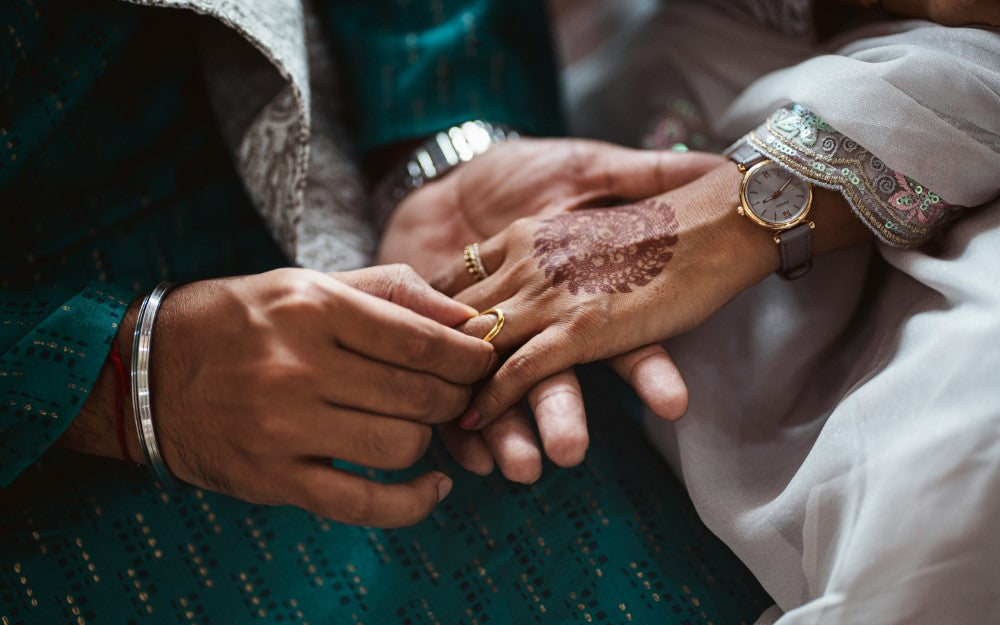
Whether to hold hands or kiss first can carry significant weight, symbolizing the initiation of intimacy and emotional connection in a relationship.
Kissing is a much more intimate gesture compared to holding hands. That's why starting with hand-holding is often a good idea in the early stages of romance.
Whether you decide to hold hands or kiss first depends on your comfort levels and timelines for physical intimacy in your unique relationship. Each couple is different and has its own personal factors that influence pivotal moments in the early stages of love.
Let's unravel the layers of meaning behind these gestures and discover how they shape the course of romantic relationships so you can navigate yours with confidence and comfort.
Panaprium ist stolz darauf, 100 % unabhängig, frei von jeglichem Einfluss und nicht gesponsert zu sein. Wir wählen sorgfältig Produkte von Marken aus, denen wir vertrauen. Vielen Dank, dass Sie über unseren Link etwas kaufen, da wir möglicherweise eine Provision erhalten, die uns unterstützt.
The Significance of Kissing vs Hand-Holding
A first kiss can signify various things depending on the context and the individuals involved. In the context of a budding romantic relationship, a first kiss often symbolizes mutual attraction and romantic interest.
It can be a pivotal moment that confirms the chemistry between two individuals and signals the beginning of a deeper connection. It represents a significant step towards emotional intimacy and closeness. It's a gesture that conveys vulnerability and trust, indicating a willingness to share a more profound connection with another person.
Kissing is a physical expression of desire and affection. It communicates a strong emotional bond and a desire to express feelings in a tangible, intimate way.
For many people, a first kiss marks an important milestone in the progression of a relationship. It signifies the transition from friendship or initial attraction to a more romantic and committed partnership.
On the other hand, hand-holding is a meaningful gesture that signifies a sense of connection and intimacy between two individuals. It is a non-verbal way of expressing closeness, affection, and companionship.
Holding hands can provide a sense of support and comfort, especially during moments of vulnerability or uncertainty. It conveys reassurance and solidarity between partners.
Hand-holding in public often serves as a subtle yet visible form of displaying affection. It communicates to others that the individuals are romantically involved and feel comfortable showing affection in public settings.
Hand-holding symbolizes unity and partnership in a relationship. It represents a united front and a shared commitment to each other's well-being. It is a physical manifestation of emotional connection and reflects a deep level of understanding and mutual respect between partners.
Hand-holding is often perceived as a romantic gesture, especially in the early stages of a relationship. It signifies a desire for closeness and a willingness to establish physical contact in a gentle and respectful manner.
Read also: Is hand-holding the new flirting? What the science says.
How To Choose Between Hand-Holding or Kissing
Choosing between hand-holding or kissing is a personal decision that should be guided by mutual respect, consent, and emotional connection.
First, consider your own comfort level with physical intimacy. Reflect on what feels natural and enjoyable to you based on your feelings and emotional readiness.
Then, pay attention to your partner's body language and verbal cues. Look for signs of mutual interest and receptiveness towards physical contact.
The stage of your relationship can influence the appropriateness of each gesture. Hand-holding is often considered appropriate in the early stages of dating as it's less intense, while kissing may be reserved for when the emotional connection is deeper.
Communicate openly with your partner about boundaries and preferences regarding physical intimacy. Respect each other's comfort levels and avoid pressuring the other person into any form of physical contact.
Take into account the context and setting of your interaction. Some environments may be more conducive to hand-holding (e.g., a casual walk in the park) while others may lend themselves more to kissing (e.g., a romantic dinner).
If you're uncertain about which gesture to initiate, consider having an open conversation with your partner about your feelings and intentions. This can help create clarity and ensure that both individuals are on the same page.
Ultimately, trust your instincts and follow your heart when choosing between hand-holding or kissing. Let your genuine feelings and emotional connection guide you in expressing affection in a way that feels meaningful and authentic to both you and your partner.
Read also: If a guy holds your hand, what does it mean?
Is Holding Hands More Intimate Than Kissing?
The level of intimacy associated with holding hands versus kissing can depend on individual perspectives and the emotional context of the relationship.
Kissing is often seen as a much more intimate gesture compared to holding hands, especially a first kiss, which is also considered a significant milestone in romantic relationships.
Kissing is often viewed as a more direct expression of romantic or sexual affection compared to holding hands, which can be seen as a more casual and friendly gesture in certain contexts.
Kissing can have a stronger emotional impact and can signify a deeper level of emotional connection between partners, especially in the context of a romantic relationship.
Kissing also involves close physical contact, including lip-to-lip contact, which can feel more personal and intimate compared to holding hands, which is less physically intense.
In many cultures, kissing is associated with romantic love and is considered a more serious and intimate act compared to holding hands, which may be perceived as a gesture of companionship or affection.
How Long Should You Date Before Holding Hands?
There's no set timeline for when to hold hands in a relationship. It's important to prioritize open communication, mutual respect, and emotional connection to ensure that physical intimacy is initiated at a comfortable and meaningful moment for both partners.
The timing of when to hold hands in a relationship can vary based on individual preferences, the pace of the relationship, and cultural norms. Each couple may have different comfort levels and timelines for physical intimacy. However, here are some general guidelines to consider:
1. Establish Comfort and Connection: It's important to focus on building a strong emotional connection and establishing comfort with each other before initiating physical touch like holding hands. This can happen over the course of several dates or weeks, depending on how frequently you see each other and the depth of your conversations.
2. Mutual Interest and Readiness: Both partners should feel genuinely interested and ready for physical contact. If one person is not comfortable or ready, it's important to respect their feelings and wait until both individuals feel mutually ready for hand-holding.
3. Communication: Open communication is key. If you're unsure about when to initiate physical contact, consider having a conversation about boundaries and comfort levels. This can help ensure that both partners are on the same page and understand each other's expectations.
4. Natural Progression: Physical gestures like holding hands should ideally feel like a natural progression in the relationship. Pay attention to non-verbal cues and mutual interest to gauge when it might be appropriate to initiate hand-holding.
Should You Hold Hands On a First or Second Date?
Holding hands on a first or second date can be a sweet and affectionate gesture if both parties feel comfortable and there's mutual interest. However, it's essential to be attuned to your date's signals and respect their boundaries to ensure a positive and respectful experience for both individuals. Here are some considerations to help you make a decision:
1. Read the Situation: Pay attention to your date's body language and cues. If you sense that they are open to physical contact and there's a natural rapport between you, holding hands might feel comfortable and appropriate.
2. Respect Personal Boundaries: Be mindful of your date's comfort zone. Some people may prefer to take things slow and may not be ready for physical touch, especially on a first date. Respect their boundaries and avoid making them feel pressured.
3. Establish Connection First: Focus on building a connection through conversation and getting to know each other. Holding hands can be a way to establish physical closeness, but it's important to ensure that there's emotional connection and mutual interest before initiating physical contact.
4. Communicate Non-Verbally: Use subtle cues to gauge interest. If your date initiates light physical contact or reciprocates when you touch their arm or shoulder, it might indicate that they are comfortable with further physical interaction like holding hands.
5. Respectful Approach: If you feel unsure, it's perfectly fine to wait for the right moment or for subsequent dates to initiate physical contact. Building trust and comfort is key to establishing a healthy and respectful connection.
Should You Hold His Hand First?
Deciding whether to hold your date's hand first depends on your comfort level and the dynamics of your relationship. If you sense that there's a good connection and mutual interest, and if you feel comfortable, initiating hand-holding can be a sweet gesture.
Read also: 10 signs he wants to hold your hand.
Consider whether your date has given any indications of being open to or comfortable with physical touch. If you're unsure about directly holding hands, you can start with subtle touches like brushing arms or touching their hand briefly during conversation.
Use eye contact and smiles to convey your interest and openness to physical contact. Pay attention to how your date responds to your non-verbal cues before making a move.
If you feel confident and comfortable about initiating hand-holding, go ahead and make a gentle move. Trust your instincts and intuition. If you feel a genuine connection and believe that initiating hand-holding would be well-received, go ahead and take a respectful and considerate approach.
The initiation of physical contact should be a collaborative and respectful process where both individuals contribute based on their comfort levels and the dynamics of their relationship. Trust your instincts, communicate openly, and prioritize mutual respect and consent in all interactions.
Final Thoughts
In the dance of romance, the choice between holding hands or kissing first encapsulates the delicate balance of emotions, desires, and expectations that define early relationships.
While the decision may seem trivial on the surface, it carries profound significance, reflecting the level of connection and intimacy between two individuals.
Whether opting for the warmth of intertwined fingers or the tender touch of lips, the act itself symbolizes a willingness to bridge the gap between hearts and minds.
Each gesture speaks volumes about vulnerability, trust, and the desire for closeness. Moreover, the decision often mirrors cultural norms, personal comfort levels, and the unique chemistry shared between partners.
Ultimately, the beauty lies in the freedom to choose and the opportunity to forge meaningful connections that transcend physical boundaries.
In the end, whether it's a hand tenderly grasped or a kiss shared under the stars, what truly matters is the sincerity behind the gesture—the genuine desire to connect, to cherish, and to embark on a journey of love together.
War dieser Artikel hilfreich für Sie? Bitte teilen Sie uns in den Kommentaren unten mit, was Ihnen gefallen oder nicht gefallen hat.






























0 Kommentare